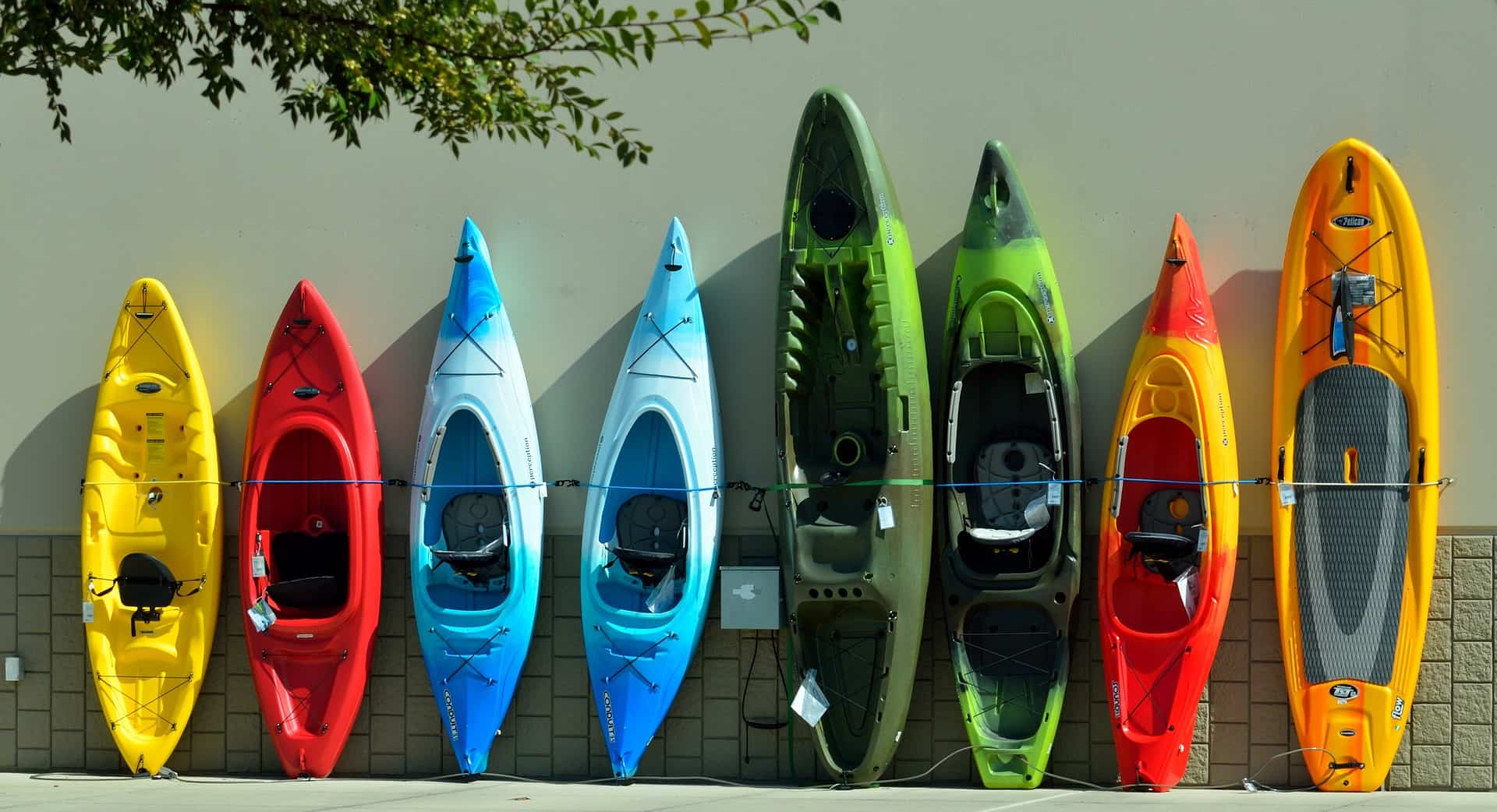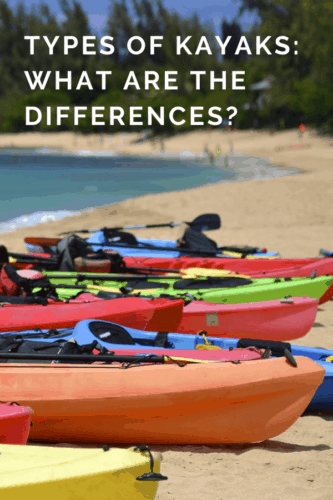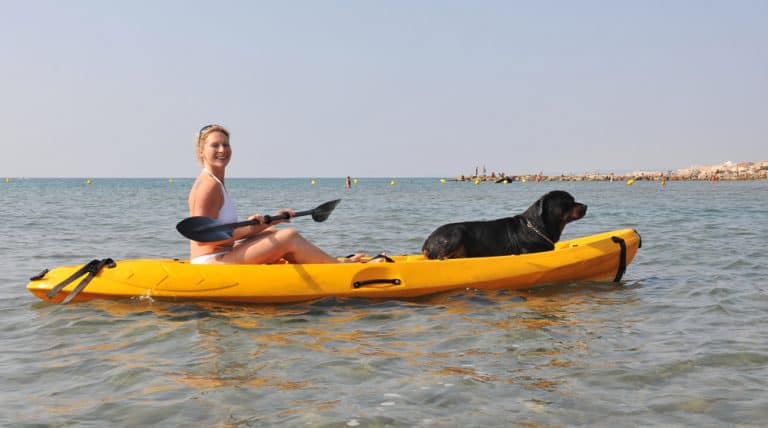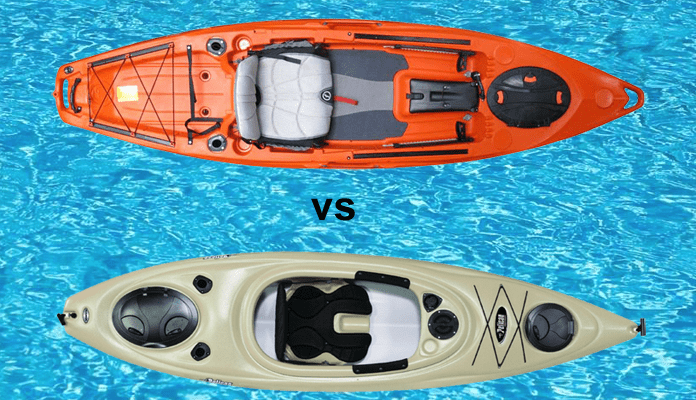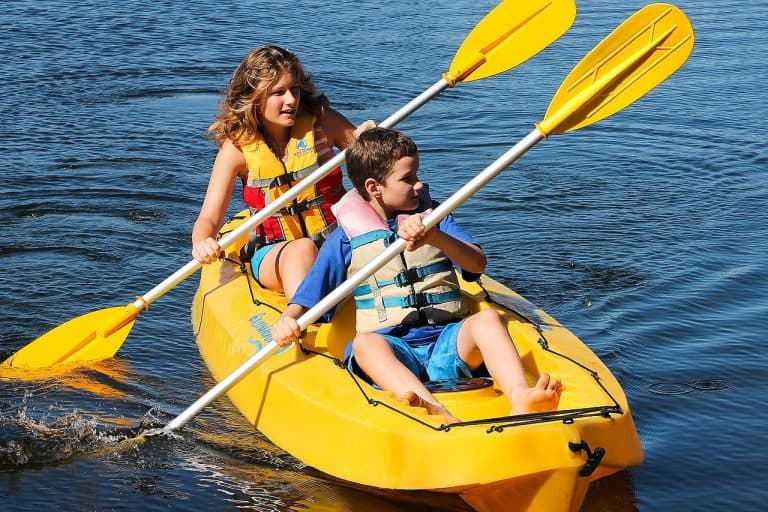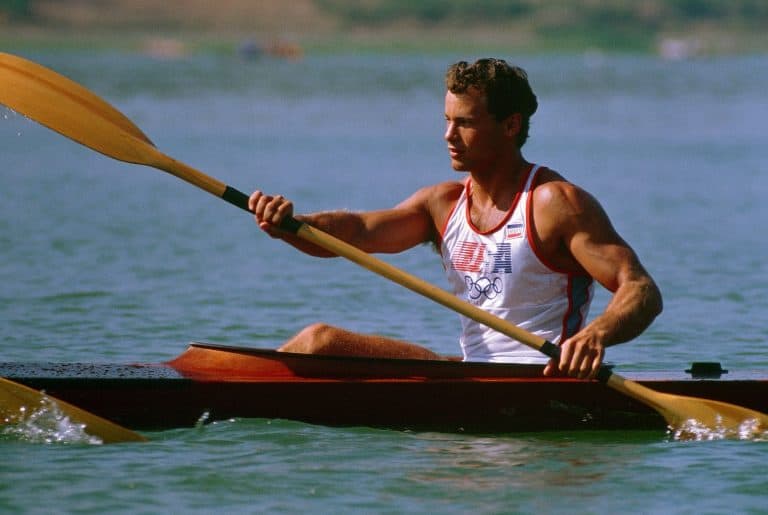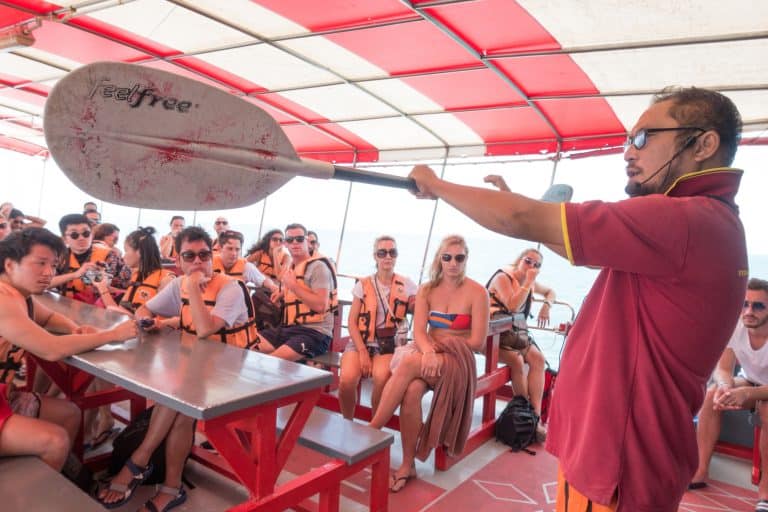One of the best things about kayaking is the vast range of activities that open up for you. From the adrenaline rush of running whitewater rapids to the placid serenity of a day out fishing on a lake.
Each activity has its specific design type of kayak to go with it. From the short and wide play boat to the long sleek lines of the sea kayak. Picking the one that fits the adventure you want to take can be tricky.
To help you, we’ve put together a guide explaining the different types of kayaks at your disposal. We will discuss their differences and what conditions you should use them in.
Different Types of Kayaks and How They Are Used
Sit-On or Sit-In Kayaks
One of the most significant differences between types of kayaks is whether they are sit-on (with a sealed hull) or sit-in (where the paddler’s lower body is inside the kayak hull).
Both kayaks have pros and cons, depending on what conditions you are paddling in.
Sit-In Kayak
When paddling in a sit-in kayak, your legs are enclosed within a cockpit. A spray skirt is attached, which stops water from coming in over the top.
Keeping your legs dry and out of the wind will help you stay warmer. So sit-ins are typically used when you’re out on colder waters.
The downside of a sit-in kayak is that if you do happen to capsize, exiting and re-entering your kayak is much more challenging than it is with a sit-on design.
Learning to exit and re-enter a sit-in kayak underwater requires a few lessons with an instructor. Additionally, with the space in the hull flooded, you will need to bail out your kayak or paddle it to shore to drain it before you can continue.
Sit-On Kayak
While a sit-in kayak keeps your legs warm and dry, getting a sit-on-top kayak means you will get wet. Spray from the waves, riffles, and paddle splashes will have you spending most of your time a bit damp. With this in mind, sit-on kayaks are best used in warmer temperatures and over warmer water.
The benefit of a sit-on design is that it is straightforward to get on and off your kayak, like when you’re boarding or just like going for a swim. It probably won’t be the most graceful thing you’ve ever done. But you can re-enter a sit-on kayak from the water.
Recreational Kayaks
Designed to be stable and easy to steer, recreational kayaks usually feature a wide hull. They are generally less than 12 feet long, have a small area to stash essentials, and include a large cockpit for easy access. They are best used on lakes, flatwater streams, or saltwater areas protected from wind and waves.
Type: Sit-on or sit-in
Pros: Recreational kayaks are built wider at the beam (the width of the hull) for increased stability, lessening the chance of you capsizing. Shorter than touring kayaks, recreational kayaks are also more maneuverable.
If you’re starting out with kayaking, then you might be more comfortable with a recreational kayak’s increased stability.
Cons: A recreational kayak’s enhanced maneuverability comes at the cost of its ability to track (keep a straight line). This means they can be difficult and tiring to paddle for long periods.
Additionally, the recreational kayak will struggle with waves and rapids because it’s designed for use in calmer waters.
Crossover Kayaks
Crossover kayaks span the gap between one style of kayak and another, such as recreational and whitewater, allowing the kayakker to tackle a number of different environments without changing boats.
You can’t combine kayaks that are utterly different, like a touring kayak and a waveski, so most crossover kayaks are based on a recreational kayak hull combined with features from more specific designs, like pole holders for fishing or a planing hull for running whitewater.
Pros
As a jack-of-all-trades, the crossover kayak will allow you to dip your toes into more rarefied forms of kayaking while still delivering solid, dependable performance in most conditions.
They are also an ideal choice for journeys that might feature multiple environments, like a river with low-grade rapids and long slow-moving sections.
Cons
Compared to specialized kayaking hulls, a crossover kayak will lack the high-end performance and additional features of a purpose-built kayak. If you are keen to involve yourself in a particular type of kayaking, such as whitewater or kayak surfing, it’s best to invest in a hull specifically designed for that activity.
Inflatable Kayaks
Most inflatable kayaks are designed to be recreational, however, there are some meant for whitewater. Before use, you can inflate them with a foot or electric pump.
Their wide and sturdy hulls make them suited to calm water. Inflatable kayaks can be folded down to a convenient size. Some models can even be worn as a backpack. Inflatable kayaks come in both sit-on and sit-in styles.
Pros
Most inflatable kayaks are made of hard-wearing, rubberized nylon that won’t bend or dent on impact with rocks. This means they can handle weather and slightly rougher waters.
They are stable and easy to maneuver, making them a great first craft for children or beginners. Some high-end models feature internal ribbing for extra stability and are designed as serious touring kayaks.
Cons
While they are rugged, any holes in an inflatable will render it useless if unable to patch, which is known to be difficult. Additionally, their high rocker and light weight mean they can be difficult to paddle in high winds or rough water.
Day-touring Kayaks
Longer and sleeker than recreational kayaks, with a hull typically 18 feet in length, the day-touring kayak moves more efficiently through the water.
This allows the boat to stay on track for longer and reduces the effort needed to paddle. Day touring kayaks are ideal for beginners looking to take extended kayaking journeys and develop their skills before moving to a touring or sea kayak.
Type: Sit-on or sit-in
Pros: Day-tourer kayaks combine the stability and portability of a recreational model but with greater control in rougher waters. They offer more storage space than recreational designs but maintain the more substantial, easy-to-access cockpit.
On top of this, as a result of them being shorter than a true touring kayak, they are easier to stow and transport.
Cons: Because day-touring kayaks are designed for a very specific purpose, the day-touring kayak only really excels in that one role. It’s not intended to be taken on long journeys, like a standard touring kayak, and is not as stable and easy to use as a recreational one.
If you are planning on only taking day trips, then this design is ideal. If you want something more multi-purpose, then I recommend investing in another kayak.
Also Read: Best Camping Kayaks
Touring Kayaks
Long and robust, the touring kayak is fast and efficient over long distances. Between 12 and 24 feet long, most designs come with one or more internal bulkheads that allow for a significant amount of internal storage. To compensate for wind or tidal movement, touring kayaks are often fitted with a rudder or skeg (a fixed rudder) to aid steering.
Type: Sit-in only
Pros: The touring kayak’s sleek silhouette and narrow beam allow it to move quickly through the water and track in a straight line for an extended period. This reduces the physical strain on the paddler and makes the kayak ideal for lengthy journeys. Larger storage capacity lets more equipment be kept on-hand. Lastly, a spray deck, and internal bulkheads lessen the chance of the kayak getting flooded.
Cons: The same length and narrow beam width that allows a touring kayak to cut efficiently through the water makes it far more difficult to make tight turns. This makes them unsuitable for narrow watercourses or those that feature a number of bends or switchbacks. Learning to evacuate and re-enter a touring kayak requires taking lessons from a professional instructor, as you have to learn to disentangle yourself from the spray deck when exiting underwater.
A touring kayak’s long length can also make them difficult to transport to the water and store when not in use.
Sea Kayaks
A variant of the touring kayak, the sea kayak has a higher rocker (the curve from bow to stern) that helps it crest into oncoming waves. It also has a narrow, V-shaped front profile.
This design makes them able to deal with rougher waters, but at the expense of stability.
Type: Sit-in only
Pros: The sea kayak is easier to control, tracks straighter, and is less likely to be swamped by waves than a standard touring kayak. This makes it specifically designed for journeys on coastal waters.
Modern sea kayaks are designed to carry large amounts of equipment. For example, expeditions of two weeks or more, in environments ranging from the tropics to the Arctic, can be taken in sea kayaks.
Cons: As with the day-touring kayak, the sea kayak is designed to excel in one environment and loses many of its advantages when taken out of that environment.
It’s higher rocker makes it less maneuverable on flat water, while it’s narrow profile makes it less stable than a standard touring kayak.
Whitewater Kayaks
Whitewater kayaks range from 4 to 10 feet in length and are specifically designed to move quickly down fast-flowing, rocky courses. They are typically made of hard-wearing rotomolded plastics.
Type: Sit-in only
Whitewater kayaks are split into two general types:
Playboats: Playboats are the shortest whitewater kayaks. They have a scooped bow and blunt stern, making playboats highly maneuverable and robust. By utilizing the speed gained by traveling through rapids, these boats are used to perform technical tricks in a sport known as rodeo boating.
Pros: Playboats are highly agile and their hulls are very resistant to damage. They excel at navigating steep, rocky waters that have fast-flowing water.
Cons: Because of their design, playboats are inherently unstable and their scooped bow makes them slow in open water.
Creekboats: Creekboats are longer and have more volume than a playboat. They are used to run narrow, low-volume waterways.
Pros: Due their stability and buoyancy, creekboats are more multi-purpose. They can be used on larger rivers. In this scenario, their greater volume allows them to navigate the flatter stretches. Their stability will enable them to negotiate rapids.
Cons: While they are multi-purpose, creekboats are not built for comfort or long journeys. They also do not have storage space.
Folding Kayaks
Based on the skin-on-frame boats used by the Inuit and Greenlandic cultures, the technology behind folding kayaks has seen significant advances in recent years.
New materials allow for full-length touring boats to be packed away into a small suitcase. They are light enough to be carried with relative ease.
This makes them the perfect solution to storage and transportation issues associated with longer, non-foldable touring kayaks.
Type: Sit-on or sit-in
Pros: Folding kayaks are unique in their ability to fold down into a portable package. They are lightweight and allow those without significant storage space to access kayaking.
Cons: The materials used to keep the kayak light are not as durable as a standard kayak hull. Folding kayaks are prone to cracking after extended use. Due to the need to fold flat, there are no internal bulkheads in a folding kayak, meaning less storage space and more opportunity for the kayak to flood.
Fishing Kayaks
As kayak fishing becomes increasingly popular, more kayaks are being made with features such as pole rests, a flatter hull for stability, pontoon stabilizers, and even pedal-powered water wheels that let you keep your hands on your fishing pole.
This type of kayak comes as both a sit-in and sit-on style.
Type: Sit-on or sit-in
Pros: Designed to be shorter and lighter than traditional touring kayaks, fishing kayaks are easier to store on a car rack and maneuver in and out of the water. Most models also offer storage space where you can keep your catch.
Cons: Because of the need for portability and a stable platform to cast your line, fishing kayaks are slower and require more energy to paddle than touring kayaks. Designed for short journeys or day trips, they lack the storage and comfort you may want for longer excursions.
Tandem Kayaks
Designed to fit two or more people, tandem kayaks are a great way to share kayaking with another person. They are also ideal for taking younger or less experienced kayakers out on the water, so they can practice their skills.
Type: Sit-on or sit-in
Pros: Tandem kayaks are ideal for beginners looking to get experience and for introducing children to the sport while under supervision. Tandem kayaks tend to have more storage space available, which is helpful for longer trips.
Cons: Tandem kayaks are heavy. Usually anywhere from 75 to 100 pounds. Even if there are two of you to help with the lifting, getting a tandem kayak into the water or stowing it on a car rack can be difficult.
Diving Kayaks
Kayak diving was popularized in the 1990s in California and is a popular alternative to using a powered boat to reach diving hotspots.
While there are no specifically manufactured diving kayaks, kayaks that are suitable for use in diving are characterized by their wide and stable beam and large storage areas. Choose from either the sit-in or sit-on type because diving kayaks come as both types.
Pros
Because there are not specifically designed diving kayaks, kayaks that work well as support boats for diving can be used in a range of other activities. Their wide beam and large storage areas make them ideal for use in camping or as a recreational kayak, extending their utility.
Cons
Because of the need to have enough room for large air tanks, and the stability to allow a diver to re-enter the kaya without flipping it, diving kayaks are often unsuited for activities such as kayak touring, which requires a narrow beam.
Surf Kayaks
Surf kayaks combine the best parts of surfing and kayaking, allowing you to take on the heavy surf from the comfort of your kayak. Surf skis can be up to 21 feet long and 16 to 20 inches wide. They use their narrow front profile to cut or punch through large, broken waves. The wave ski, a variant of the surf ski, is used to take advantage of wave swell, similar to a surfboard. Wave skis feature a wide, flat hull that is often less than 10 feet long. Surf kayaks come as both sit-in and sit-on models.
Pros
Surf skis are a very specific design of kayak. They are fantastic at what they do, allowing the paddler to combine the exhilaration of surfing and kayaking.
Cons
The specialized design of a surf ski, particularly a wave ski, makes it highly effective for its intended purpose. However, this specialization makes them almost useless at other kayaking activities.
Sail Kayaks
While still uncommon, using a sail on a kayak has been around for over 150 years. Rather than a specifically designed sailing kayak, a kayak sail is an accessory that can be attached to almost any kayak. It enhances speed and reduces the strain on the paddler. It can be added to both sit-in or sit-on type of kayak.
Pros
A kayak sail can significantly add to a paddlers ability to cross large stretches of water in a short time. It reduces the physical strain on the kayaker and is ideal for those focusing on kayak touring.
Cons
Not all kayaks are best designed to accommodate a kayak sail. Kayaks with a wider beam and shorter length may find that adding a sail unbalances them, significantly reducing their tracking. As a rule, kayak sails work best on touring and sea kayaks.
SUP Kayak Hybrid
SUP, or stand-up paddleboarding, is a paddlesport that has grown significantly in popularity recently. As this mirrors the growth in popularity of kayaking, it’s no surprise that there was a call for the two sports to be combined. A SUP Kayak Hybrid retains all the features of a stand-up paddleboard with the addition of a seat and double-ended kayak paddle. By adding kayak elements to an SUP, the hybrid allows the paddler to rest when taking longer journeys or sit down to paddle in rougher conditions.
Pros
The addition of a kayaking seat to a SUP allows the paddler to tackle longer distances or slightly rougher weather by taking some of the physical stress off them and adding in more control.
Cons
The SUP hybrid has a very narrow margin of utility and is often outclassed by standard kayaks or SUPs. It’s best to investigate exactly how adding a kayak seat will positively affect your SUP experience before buying one.
Specialist Kayaks
Specialist kayaks are designed with a single purpose, usually a kayak-based sport, in mind. Most people won’t encounter or need a specialist kayak unless they are interested in that particular activity. Specialist kayaks function extremely well when used for what they were designed for. Their performance drops significantly when used for other purposes.
Type: Sit-on or Sit-in
Some examples of specialist kayaks are:
Squirt Boats: With a volume that is less than half of a normal kayak of the same length, squirt boats are ultra-light and flat while still accommodating the kayaker’s legs. Designed for whitewater kayaking, 70 to 80 percent of a squirt boat sits underwater. So it can take advantage of underwater currents to perform quick maneuvers.
Surf Ski and Wave Ski: Surf skis can be up to 21 feet long and 16 to 20 inches wide. They use their narrow front profile to cut or punch through large, broken waves. The wave ski, a variant of the surf ski, is used to take advantage of wave swell, similar to a surfboard. Wave skis feature a wide, flat hull that is often less than 10 feet long.
Slalom Kayaking: Designed to be used in whitewater slalom races, slalom kayaks have a flat, saucer-shaped hull with a high rocker. This makes them very maneuverable and able to make tight turns at high speed, but slow over open water.
The Verdict – Finding The Right Type of Kayak For You
As kayaking gains popularity, more people are enjoying the range of activities you can enjoy in a kayak.
The trick is understanding the differences between the many kayak types available. So, you find one that matches up with your preferred activity.
If you want to spend a long time on the water, you’ll need a touring kayak for long-term comfort and storage space for supplies. But if you want the adrenaline rush of running whitewater rapids, then it’s a rugged, maneuverable playboat for you. Want to spend a few quiet hours fishing? A fishing kayak will let you pedal with your feet to keep your hands free and focused on your catch.
Once you’ve found your perfect kayak, you’re well on your way to having a great time on the water.
More From KayakHelp:
- How Much Does A Kayak Weigh
- Anatomy Of A Kayak – Parts Explained
- Best Kayaks For Beginners
- Beginners’ Guide To Kayak Terminology
- Is Kayaking Expensive?

